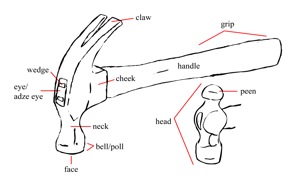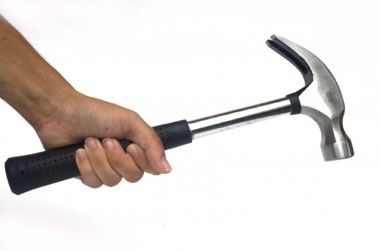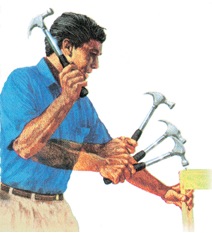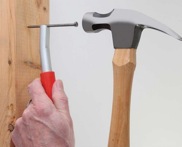Blog
How to use a hammer safely

A hammer is one of several basic tools an average person has in his toolbox. Depending on the type of work to be done, a large variety of hammers is available, such as Ball-Peen hammer, Claw hammer, Engineer's hammer, mallets, etc. Almost all hammers have a steel head and a handle. Mallets may have a wooden head or a steel head with nylon ends.
Except the mallet, all hammers are good for pounding-in nails. At least one side of the steel head is reserved for this purpose and is called the “faceâ€. The other end may be similar to the face as in the case of an Engineer's hammer, but it is not so for the ball-peen or the claw hammer. The ball-peen hammer has a rounded head for working with sheet metal, while the claw hammer has a “claw†with two fingers on one side and is suitable for pulling out nails when working on wood.

Before using a hammer, it is a good idea to check it out thoroughly. The head must be securely held on the handle. If it is a wooden handle, there will be wedges in the eye that hold it firmly in place. Check that the wedges are not loose. Use another lighter hammer to drive any loose wedges firmly into place. Modern hammers have metal handles or molded handles that will not let the head slip off.

The handle of a hammer is usually contoured. The middle of the handle, nearer the head has a bulge. Then the handle tapers down to form a waist (also called the grip), finally ending in a slight flare at the end. This helps to have a firm grip on the hammer during use. The most comfortable and safe way is to hold the hammer by closing your fist on waist part of the handle with your thumb and index finger towards the head.

A hammer works under its own momentum. The usual practice is to swing the hammer up over your head and bring it down so that the flat face of the head hits the nail. As the hammer travels down, it gains momentum and its entire energy is transferred to the nail on contact. Your hand is only to facilitate the movement of the hammer and there is no transfer of energy from your hand. A 1lb. Hammer packs enough punch roughly equal to that of a bullet fired from a .300 Magnum.
Therefore, for safe use, grip the handle of your hammer firmly, but not too tightly. The hammer should have some play in your hand, but must not fly out of your hand as you swing it. It is important to hold the nail firmly in place when starting, but not with your fingers; use a pair of long-nosed pliers. Remember that nearly 50,000 Americans seek treatment every year for injuries caused by wrong use of hammers.
Since you have to swing your hammer above your head, it is advisable to have sufficient amount of clear space behind, above and in front of you when working with a hammer. Preferably, do not allow anyone to stand in front of your workbench or behind it. The hammer's head, if loose, may slip off the handle when you are raising the hammer up, and is likely to fly backwards.

Place your job on a firm surface such as the top of a workbench. Make sure it is held firmly and is unable to move when the hammer strikes. It is best to have the job at your waist height if placed horizontally on the workbench and about face-high if you are hammering on a vertical surface. You may have to crouch on the floor or climb onto a platform to get into the proper position when hammering on a vertical surface.
You need trial and error to get a good hammering technique. Over time, this will become comfortable and you will be able to work safely on your projects.
overall rating:
my rating:
log in to rate

